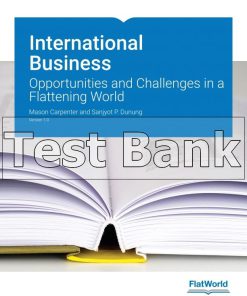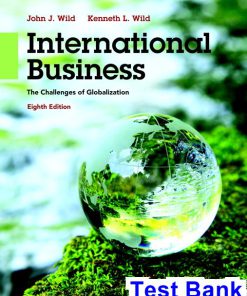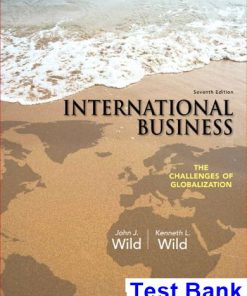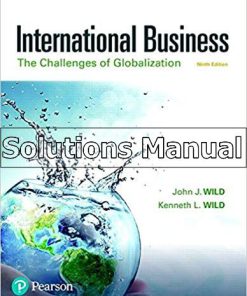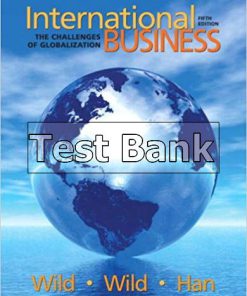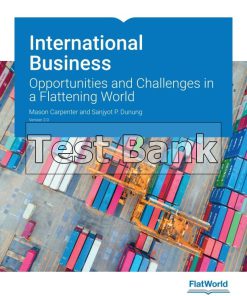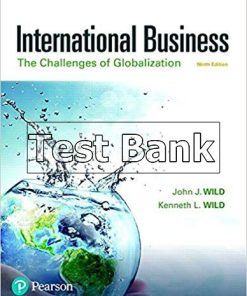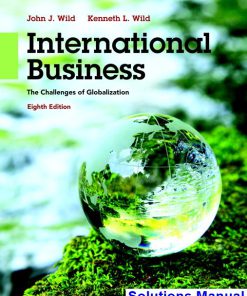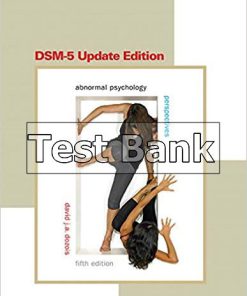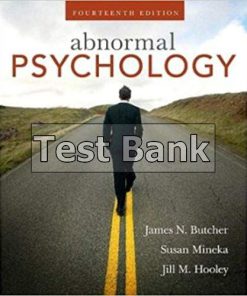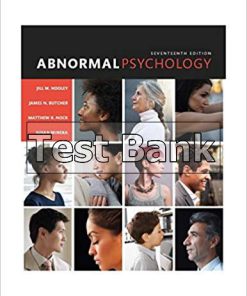International Business The Challenges of Globalization Canadian 1st Edition Wild Test Bank
$50.00 Original price was: $50.00.$26.50Current price is: $26.50.
International Business The Challenges of Globalization Canadian 1st Edition Wild Test Bank.
International Business The Challenges of Globalization Canadian 1st Edition Wild Test Bank
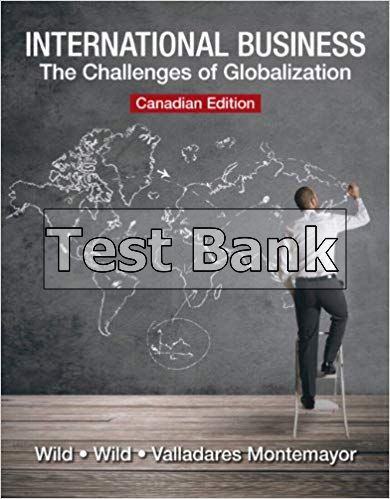
Product details:
- ISBN-10 : 0132866889
- ISBN-13 : 978-0132866880
- Author: John Wild, Kenneth Wild, and Halia M. Valladares Montemayor
A global snapshot from a Canadian perspective, this dynamic text brings real world challenges to the forefront for today’s diverse students.
The book’s visual style is innovative yet subtle and uses photos, illustrations, and features sparingly. The result is an easy-to-read and clutter-free design.
Table contents:
- Part 1 Global Business Environment
- Chapter One Globalization
- Learning Objectives
- 1.1 Key Players in International Business
- Multinational Corporations
- Entrepreneurs and Small Businesses
- QUICK STUDY 1
- 1.2 What is Globalization?
- Globalization of Markets
- REDUCES MARKETING COSTS
- CREATES NEW MARKET OPPORTUNITIES
- LEVELS UNEVEN INCOME STREAMS
- LOCAL BUYERS’ NEEDS
- GLOBAL SUSTAINABILITY
- Globalization of Production
- ACCESS LOWER-COST WORKERS
- ACCESS TECHNICAL EXPERTISE
- ACCESS PRODUCTION INPUTS
- QUICK STUDY 2
- 1.3 Forces Driving Globalization
- Falling Barriers to Trade and Investment
- WORLD TRADE ORGANIZATION
- OTHER INTERNATIONAL ORGANIZATIONS
- REGIONAL TRADE AGREEMENTS
- TRADE AND NATIONAL OUTPUT
- Technological Innovation
- EMAIL AND VIDEOCONFERENCING
- THE INTERNET
- COMPANY INTRANETS AND EXTRANETS
- ADVANCEMENTS IN TRANSPORTATION TECHNOLOGIES
- Measuring Globalization
- QUICK STUDY 3
- 1.4 Debate about Jobs and Wages
- Against Globalization
- ELIMINATES JOBS IN DEVELOPED NATIONS
- LOWERS WAGES IN DEVELOPED NATIONS
- EXPLOITS WORKERS IN DEVELOPING NATIONS
- For Globalization
- INCREASES WEALTH AND EFFICIENCY IN ALL NATIONS
- GENERATES LABOR MARKET FLEXIBILITY IN DEVELOPED NATIONS
- ADVANCES THE ECONOMIES OF DEVELOPING NATIONS
- Summary of the Jobs and Wages Debate
- QUICK STUDY 4
- 1.5 Debate about Income Inequality
- Inequality within Nations
- Inequality between Nations
- Global Inequality
- SUMMARY OF THE INCOME INEQUALITY DEBATE
- QUICK STUDY 5
- 1.6 Debate about Culture, Sovereignty, and the Environment
- Globalization and Culture
- Globalization and National Sovereignty
- GLOBALIZATION: MENACE TO DEMOCRACY?
- GLOBALIZATION: GUARDIAN OF DEMOCRACY?
- Globalization and the Environment
- QUICK STUDY 6
- 1.7 Developing Skills for your Career
- The Global Business Environment
- The Road Ahead for International Business
- QUICK STUDY 7
- Chapter Summary
- Key Terms
- Ethical Challenge
- Teaming Up
- Market Entry Strategy Project
- Appendix
- World Atlas
- Map Exercises
- Answers
- Self-Assessment
- Part 2 National Business Environments
- Chapter Two Cross-Cultural Business
- Learning Objectives
- 2.1 What is Culture?
- National Culture
- Subcultures
- Physical Environment
- Need for Cultural Knowledge
- AVOIDING ETHNOCENTRICITY
- DEVELOPING CULTURAL LITERACY
- QUICK STUDY 1
- 2.2 Values and Behavior
- Values
- Attitudes
- Aesthetics
- Appropriate Behavior
- MANNERS
- CUSTOMS
- Folk and Popular Customs
- Gift Giving Customs
- QUICK STUDY 2
- 2.3 Social Structure and Education
- Social Group Associations
- FAMILY
- GENDER
- Social Status
- Social Mobility
- CASTE SYSTEM
- CLASS SYSTEM
- Education
- THE “BRAIN DRAIN” PHENOMENON
- QUICK STUDY 3
- 2.4 Religion
- Christianity
- Islam
- Hinduism
- Buddhism
- Confucianism
- Judaism
- Shinto
- QUICK STUDY 4
- 2.5 Personal Communication
- Spoken and Written Language
- IMPLICATIONS FOR MANAGERS
- LANGUAGE BLUNDERS
- LINGUA FRANCA
- Body Language
- QUICK STUDY 5
- 2.6 Culture in the Global Workplace
- Perception of Time
- View of Work
- Material Culture
- Cultural Change
- WHEN COMPANIES CHANGE CULTURES
- WHEN CULTURES CHANGE COMPANIES
- Studying Culture in the Workplace
- KLUCKHOHN-STRODTBECK FRAMEWORK
- Case: Japanese Culture
- HOFSTEDE FRAMEWORK
- QUICK STUDY 6
- Chapter Summary
- Key Terms
- Ethical Challenge
- Teaming Up
- Market Entry Strategy Project
- Chapter Three Political Economy and Ethics
- Learning Objectives
- 3.1 Political Systems
- Totalitarianism
- THEOCRATIC TOTALITARIANISM
- SECULAR TOTALITARIANISM
- DOING BUSINESS IN TOTALITARIAN COUNTRIES
- Democracy
- REPRESENTATIVE DEMOCRACY
- DOING BUSINESS IN DEMOCRACIES
- QUICK STUDY 1
- 3.2 Economic Systems
- Centrally Planned Economy
- ORIGINS OF THE CENTRALLY PLANNED ECONOMY
- DECLINE OF CENTRAL PLANNING
- Failure to Create Economic Value
- Failure to Provide Incentives
- Failure to Achieve Rapid Growth
- Failure to Satisfy Consumer Needs
- Mixed Economy
- ORIGINS OF THE MIXED ECONOMY
- DECLINE OF MIXED ECONOMIES
- Move toward Privatization
- Market Economy
- ORIGINS OF THE MARKET ECONOMY
- Laissez-Faire Economics
- FEATURES OF A MARKET ECONOMY
- GOVERNMENT’S ROLE IN A MARKET ECONOMY
- Enforcing Antitrust Laws
- Preserving Property Rights
- Providing a Stable Fiscal and Monetary Environment
- Preserving Political Stability
- ECONOMIC FREEDOM
- QUICK STUDY 2
- 3.3 Legal Systems
- Common Law
- Civil Law
- Theocratic Law
- QUICK STUDY 3
- 3.4 Global Legal Issues
- Intellectual Property
- INDUSTRIAL PROPERTY
- COPYRIGHTS
- Product Safety and Liability
- Taxation
- Antitrust Regulations
- QUICK STUDY 4
- 3.5 Ethics and Social Responsibility
- Philosophies of Ethics and Social Responsibility
- Bribery and Corruption
- Labor Conditions and Human Rights
- Fair Trade Practices
- Environment
- QUICK STUDY 5
- Chapter Summary
- Key Terms
- Ethical Challenge
- Teaming Up
- Market Entry Strategy Project
- Chapter Four Economic Development of Nations
- Learning Objectives
- 4.1 Economic Development
- Classifying Countries
- DEVELOPED COUNTRIES
- NEWLY INDUSTRIALIZED COUNTRIES
- DEVELOPING COUNTRIES
- National Production
- UNCOUNTED TRANSACTIONS
- QUESTION OF GROWTH
- PROBLEM OF AVERAGES
- PITFALLS OF COMPARISON
- Purchasing Power Parity
- Human Development
- QUICK STUDY 1
- 4.2 Economic Transition
- Managerial Expertise
- Shortage of Capital
- Cultural Differences
- Sustainability
- QUICK STUDY 2
- 4.3 Political Risk
- Conflict and Violence
- Terrorism and Kidnapping
- Property Seizure
- Policy Changes
- Local Content Requirements
- QUICK STUDY 3
- 4.4 Managing Political Risk
- Adaptation
- Information Gathering
- Political Influence
- International Relations
- The United Nations
- QUICK STUDY 4
- 4.5 Emerging Markets and Economic Transition
- China’s Profile
- Chinese Patience and Guanxi
- China’s Challenges
- Russia’s Profile
- Russia’s Challenges
- QUICK STUDY 5
- Chapter Summary
- Key Terms
- Ethical Challenge
- Teaming Up
- Market Entry Strategy Project
- Part 3 International Trade and Investment
- Chapter Five International Trade Theory
- Learning Objectives
- 5.1 Benefits, Volume, and Patterns of International Trade
- Benefits of International Trade
- Volume of International Trade
- International Trade Patterns
- Trade Interdependence
- TRADE DEPENDENCE
- QUICK STUDY 1
- 5.2 Mercantilism
- How Mercantilism Worked
- TRADE SURPLUSES
- GOVERNMENT INTERVENTION
- COLONIALISM
- Flaws of Mercantilism
- QUICK STUDY 2
- 5.3 Theories of Absolute and Comparative Advantage
- Absolute Advantage
- CASE: RICELAND AND TEALAND
- Gains from Specialization and Trade
- Comparative Advantage
- Gains from Specialization and Trade
- ASSUMPTIONS AND LIMITATIONS
- QUICK STUDY 3
- 5.4 Factor Proportions Theory
- Labor Versus Land and Capital Equipment
- Evidence on Factor Proportions Theory: The Leontief Paradox
- QUICK STUDY 4
- 5.5 International Product Life Cycle
- Stages of the Product Life Cycle
- Limitations of the Theory
- QUICK STUDY 5
- 5.6 New Trade Theory
- First-Mover Advantage
- QUICK STUDY 6
- 5.7 National Competitive Advantage
- Factor Conditions
- ADVANCED FACTORS
- Demand Conditions
- Related and Supporting Industries
- Firm Strategy, Structure, and Rivalry
- Government and Chance
- QUICK STUDY 7
- Chapter Summary
- Key Terms
- Ethical Challenge
- Teaming Up
- Market Entry Strategy Project
- Chapter Six Political Economy of Trade
- Learning Objectives
- 6.1 Why do Governments Intervene in Trade?
- Political Motives
- PROTECT JOBS
- PRESERVE NATIONAL SECURITY
- National Security and Imports
- National Security and Exports
- RESPOND TO “UNFAIR” TRADE
- GAIN INFLUENCE
- Economic Motives
- PROTECT INFANT INDUSTRIES
- PURSUE STRATEGIC TRADE POLICY
- Benefits of Strategic Trade Policy
- Drawbacks of Strategic Trade Policy
- Cultural Motives
- CULTURAL INFLUENCE OF THE UNITED STATES
- QUICK STUDY 1
- 6.2 Instruments of Trade Promotion
- Subsidies
- DRAWBACKS OF SUBSIDIES
- Export Financing
- Foreign Trade Zones
- Special Government Agencies
- QUICK STUDY 2
- 6.3 Instruments of Trade Restriction
- Tariffs
- PROTECT DOMESTIC PRODUCERS
- GENERATE REVENUE
- Quotas
- REASON FOR IMPORT QUOTAS
- REASONS FOR EXPORT QUOTAS
- Voluntary Export Restraints
- TARIFF-QUOTAS
- Embargoes
- Local Content Requirements
- Administrative Delays
- Currency Controls
- QUICK STUDY 3
- 6.4 Global Trading System
- General Agreement on Tariffs and Trade (GATT)
- URUGUAY ROUND OF NEGOTIATIONS
- Agreement on Services
- Agreement on Intellectual Property
- Agreement on Agricultural Subsidies
- World Trade Organization (WTO)
- DISPUTE SETTLEMENT IN THE WTO
- DUMPING AND THE WTO
- SUBSIDIES AND THE WTO
- DOHA ROUND OF NEGOTIATIONS
- WTO AND THE ENVIRONMENT
- QUICK STUDY 4
- Chapter Summary
- Key Terms
- Ethical Challenge
- Teaming Up
- Market Entry Strategy Project
- Chapter Seven Foreign Direct Investment
- Learning Objectives
- 7.1 Pattern of Foreign Direct Investment
- Ups and Downs of FDI
- GLOBALIZATION
- MERGERS AND ACQUISITIONS
- Worldwide Flows of FDI
- QUICK STUDY 1
- 7.2 Theories of Foreign Direct Investment
- International Product Life Cycle
- Market Imperfections (Internalization)
- TRADE BARRIERS
- SPECIALIZED KNOWLEDGE
- Eclectic Theory
- Market Power
- QUICK STUDY 2
- 7.3 Management Issues and Foreign Direct Investment
- Control
- PARTNERSHIP REQUIREMENTS
- BENEFITS OF COOPERATION
- Purchase-or-Build Decision
- Production Costs
- RATIONALIZED PRODUCTION
- MEXICO’S MAQUILADORA
- COST OF RESEARCH AND DEVELOPMENT
- Customer Knowledge
- Following Clients
- Following Rivals
- QUICK STUDY 3
- 7.4 Why Governments Intervene in FDI
- Balance of Payments
- CURRENT ACCOUNT
- CAPITAL ACCOUNT
- Reasons for Intervention by the Host Country
- CONTROL BALANCE OF PAYMENTS
- OBTAIN RESOURCES AND BENEFITS
- ACCESS TO TECHNOLOGY
- MANAGEMENT SKILLS AND EMPLOYMENT
- Reasons for Intervention by the Home Country
- QUICK STUDY 4
- 7.5 Government Policy Instruments and FDI
- Host Countries: Promotion
- FINANCIAL INCENTIVES
- INFRASTRUCTURE IMPROVEMENTS
- Host Countries: Restriction
- OWNERSHIP RESTRICTIONS
- PERFORMANCE DEMANDS
- Home Countries: Promotion
- Home Countries: Restriction
- QUICK STUDY 5
- Chapter Summary
- Key Terms
- Ethical Challenge
- Teaming Up
- Market Entry Strategy Project
- Chapter Eight Regional Economic Integration
- Learning Objectives
- 8.1 Levels of Integration and the Debate
- Free Trade Area
- Customs Union
- Common Market
- Economic Union
- Political Union
- The Case for Regional Integration
- TRADE CREATION
- GREATER CONSENSUS
- POLITICAL COOPERATION
- EMPLOYMENT OPPORTUNITIES
- CORPORATE SAVINGS
- The Case Against Regional Integration
- TRADE DIVERSION
- SHIFTS IN EMPLOYMENT
- LOSS OF NATIONAL SOVEREIGNTY
- QUICK STUDY 1
- 8.2 Integration in Europe
- European Union
- EARLY YEARS
- Single European Act
- Maastricht Treaty
- EUROPEAN MONETARY UNION
- Management Implications of the Euro
- ENLARGEMENT OF THE EUROPEAN UNION
- STRUCTURE OF THE EU
- European Parliament
- Council of the EU
- European Commission
- Court of Justice
- Court of Auditors
- European Free Trade Association (EFTA)
- QUICK STUDY 2
- 8.3 Integration in the Americas
- North American Free Trade Agreement
- LOCAL CONTENT REQUIREMENTS AND RULES OF ORIGIN
- EFFECTS OF NAFTA
- EXPANSION OF NAFTA
- Central American Free Trade Agreement (CAFTA-DR)
- Andean Community (CAN)
- Southern Common Market (MERCOSUR)
- Central America and the Caribbean
- CARIBBEAN COMMUNITY AND COMMON MARKET (CARICOM)
- CENTRAL AMERICAN COMMON MARKET (CACM)
- Free Trade Area of the Americas (FTAA)
- QUICK STUDY 3
- 8.4 Integration in Asia and Elsewhere
- Association of Southeast Asian Nations (ASEAN)
- Asia Pacific Economic Cooperation (APEC)
- THE RECORD OF APEC
- Closer Economic Relations (CER) Agreement
- Gulf Cooperation Council (GCC)
- Economic Community of West African States (ECOWAS)
- African Union (AU)
- QUICK STUDY 4
- Chapter Summary
- Key Terms
- Ethical Challenge
- Teaming Up
- Market Entry Strategy Project
- Part 4 The International Financial System
- Chapter Nine International Financial Markets
- Learning Objectives
- 9.1 Importance of the International Capital Market
- Purposes of National Capital Markets
- ROLE OF DEBT
- ROLE OF EQUITY
- Purposes of the International Capital Market
- EXPANDS THE MONEY SUPPLY FOR BORROWERS
- REDUCES THE COST OF MONEY FOR BORROWERS
- REDUCES RISK FOR LENDERS
- Forces Expanding the International Capital Market
- World Financial Centers
- OFFSHORE FINANCIAL CENTERS
- QUICK STUDY 1
- 9.2 International Capital Market Components
- International Bond Market
- TYPES OF INTERNATIONAL BONDS
- INTEREST RATES: A DRIVING FORCE
- International Equity Market
- SPREAD OF PRIVATIZATION
- ECONOMIC GROWTH IN EMERGING MARKETS
- ACTIVITY OF INVESTMENT BANKS
- ADVENT OF CYBERMARKETS
- Eurocurrency Market
- APPEAL OF THE EUROCURRENCY MARKET
- QUICK STUDY 2
- 9.3 The Foreign Exchange Market
- Functions of the Foreign Exchange Market
- CURRENCY CONVERSION
- CURRENCY HEDGING
- CURRENCY ARBITRAGE
- CURRENCY SPECULATION
- QUICK STUDY 3
- 9.4 Currency Quotes and Rates
- Quoting Currencies
- DIRECT AND INDIRECT RATE QUOTES
- CROSS RATES
- Spot Rates
- BUY AND SELL RATES
- Forward Rates
- FORWARD CONTRACTS
- Swaps, Options, and Futures
- CURRENCY SWAPS
- CURRENCY OPTIONS
- CURRENCY FUTURES CONTRACTS
- QUICK STUDY 4
- 9.5 Market Instruments and Institutions
- Trading Centers
- Important Currencies
- Interbank Market
- CLEARING MECHANISMS
- Securities Exchanges
- Over-the-Counter Market
- CURRENCY RESTRICTION
- Instruments for Restricting Currencies
- QUICK STUDY 5
- Chapter Summary
- Key Terms
- Ethical Challenge
- Teaming Up
- Market Entry Strategy Project
- Appendix
- Calculating Percent Change in Exchange Rates
- Chapter Ten International Monetary System
- Learning Objectives
- 10.1 Importance of Exchange Rates
- Desire for Predictability and Stability
- Efficient versus Inefficient Market View
- Forecasting Techniques
- Difficulties of Forecasting
- QUICK STUDY 1
- 10.2 What Factors Determine Exchange Rates?
- Law of One Price
- MCCURRENCY
- Purchasing Power Parity
- NUMERICAL EXAMPLE
- ROLE OF INFLATION
- Impact of Money-Supply Decisions
- Impact of Unemployment and Interest Rates
- How Exchange Rates Adjust to Inflation
- ROLE OF INTEREST RATES
- Fisher Effect
- EVALUATING PPP
- Impact of Added Costs
- Impact of Trade Barriers
- Impact of Business Confidence and Psychology
- QUICK STUDY 2
- 10.3 Fixed Exchange Rate Systems
- The Gold Standard
- PAR VALUE
- ADVANTAGES OF THE GOLD STANDARD
- COLLAPSE OF THE GOLD STANDARD
- Bretton Woods Agreement
- FIXED EXCHANGE RATES
- BUILT-IN FLEXIBILITY
- WORLD BANK
- INTERNATIONAL MONETARY FUND
- Special Drawing Right
- COLLAPSE OF THE BRETTON WOODS AGREEMENT
- Smithsonian Agreement
- Final Days
- QUICK STUDY 3
- 10.4 System of Floating Exchange Rates
- Today’s Exchange-Rate Arrangements
- PEGGED EXCHANGE-RATE ARRANGEMENT
- CURRENCY BOARD
- European Monetary System
- HOW THE SYSTEM WORKED
- Recent Financial Crises
- DEVELOPING NATIONS’ DEBT CRISIS
- MEXICO’S PESO CRISIS
- SOUTHEAST ASIA’S CURRENCY CRISIS
- RUSSIA’S RUBLE CRISIS
- ARGENTINA’S PESO CRISIS
- Future of the International Monetary System
- QUICK STUDY 4
- Chapter Summary
- Key Terms
- Ethical Challenge
- Teaming Up
- Market Entry Strategy Project
- Part 5 International Business Management
- Chapter Eleven International Strategy and Organization
- Learning Objectives
- 11.1 Company Analysis
- Company Mission and Goals
- TYPES OF MISSION STATEMENTS
- Core Competency and Value-Creation
- UNIQUE ABILITIES OF COMPANIES
- VALUE-CHAIN ANALYSIS
- Primary Activities
- Support Activities
- NATIONAL AND INTERNATIONAL BUSINESS ENVIRONMENTS
- QUICK STUDY 1
- 11.2 Strategy Formulation
- Two International Strategies
- MULTINATIONAL STRATEGY
- GLOBAL STRATEGY
- Corporate-Level Strategies
- GROWTH STRATEGY
- RETRENCHMENT STRATEGY
- STABILITY STRATEGY
- COMBINATION STRATEGY
- Business-Level Strategies
- LOW-COST LEADERSHIP STRATEGY
- DIFFERENTIATION STRATEGY
- FOCUS STRATEGY
- Department-Level Strategies
- PRIMARY AND SUPPORT ACTIVITIES
- QUICK STUDY 2
- 11.3 Issues of Organizational Structure
- Centralization versus Decentralization
- WHEN TO CENTRALIZE
- WHEN TO DECENTRALIZE
- Participative Management and Accountability
- Coordination and Flexibility
- STRUCTURE AND COORDINATION
- STRUCTURE AND FLEXIBILITY
- QUICK STUDY 3
- 11.4 Types of Organizational Structure
- International Division Structure
- International Area Structure
- Global Product Structure
- Global Matrix Structure
- Work Teams
- SELF-MANAGED TEAMS
- CROSS-FUNCTIONAL TEAMS
- GLOBAL TEAMS
- QUICK STUDY 4
- A Final Word
- Chapter Summary
- Key Terms
- Ethical Challenge
- Teaming Up
- Chapter Twelve Analyzing International Opportunities
- Learning Objectives
- 12.1 Basic Appeal and National Factors
- Step 1: Identify Basic Appeal
- DETERMINING BASIC DEMAND
- DETERMINING AVAILABILITY OF RESOURCES
- Step 2: Assess the National Business Environment
- CULTURAL FORCES
- POLITICAL AND LEGAL FORCES
- Government Regulation
- Government Bureaucracy
- Political Stability
- ECONOMIC AND FINANCIAL FORCES
- OTHER FORCES
- Cost of Transporting Materials and Goods
- Country Image
- QUICK STUDY 1
- 12.2 Measure and Select the Market or Site
- Step 3: Measure Market or Site Potential
- MEASURING MARKET POTENTIAL
- Industrialized Markets
- Emerging Markets
- MEASURING SITE POTENTIAL
- Step 4: Select the Market or Site
- FIELD TRIPS
- COMPETITOR ANALYSIS
- QUICK STUDY 2
- 12.3 Secondary Market Research
- International Organizations
- Government Agencies
- Industry and Trade Associations
- Service Organizations
- Internet
- Problems with Secondary Research
- AVAILABILITY OF DATA
- COMPARABILITY OF DATA
- QUICK STUDY 3
- 12.4 Primary Market Research
- Trade Shows and Trade Missions
- Interviews and Focus Groups
- Surveys
- Environmental Scanning
- Problems with Primary Research
- QUICK STUDY 4
- A Final Word
- Chapter Summary
- Key Terms
- Ethical Challenge
- Teaming Up
- Chapter Thirteen Selecting and Managing Entry Modes
- Learning Objectives
- 13.1 Exporting, Importing, and Countertrade
- Why Companies Export
- Developing an Export Strategy: A Four-Step Model
- STEP 1: IDENTIFY A POTENTIAL MARKET
- STEP 2: MATCH NEEDS TO ABILITIES
- STEP 3: INITIATE MEETINGS
- STEP 4: COMMIT RESOURCES
- Degree of Export Involvement
- DIRECT EXPORTING
- Sales Representatives
- Distributors
- INDIRECT EXPORTING
- Agents
- Export Management Companies
- Export Trading Companies
- Avoiding Export and Import Blunders
- Countertrade
- TYPES OF COUNTERTRADE
- QUICK STUDY 1
- 13.2 Export/Import Financing
- Advance Payment
- Documentary Collection
- Letter of Credit
- Open Account
- QUICK STUDY 2
- 13.3 Contractual Entry Modes
- Licensing
- ADVANTAGES OF LICENSING
- DISADVANTAGES OF LICENSING
- Franchising
- ADVANTAGES OF FRANCHISING
- DISADVANTAGES OF FRANCHISING
- Management Contracts
- ADVANTAGES OF MANAGEMENT CONTRACTS
- DISADVANTAGES OF MANAGEMENT CONTRACTS
- Turnkey Projects
- ADVANTAGES OF TURNKEY PROJECTS
- DISADVANTAGES OF TURNKEY PROJECTS
- QUICK STUDY 3
- 13.4 Investment Entry Modes
- Wholly Owned Subsidiaries
- ADVANTAGES OF WHOLLY OWNED SUBSIDIARIES
- DISADVANTAGES OF WHOLLY OWNED SUBSIDIARIES
- Joint Ventures
- JOINT VENTURE CONFIGURATIONS
- Forward Integration Joint Venture
- Backward Integration Joint Venture
- Buyback Joint Venture
- Multistage Joint Venture
- ADVANTAGES OF JOINT VENTURES
- DISADVANTAGES OF JOINT VENTURES
- Strategic Alliances
- ADVANTAGES OF STRATEGIC ALLIANCES
- DISADVANTAGES OF STRATEGIC ALLIANCES
- QUICK STUDY 4
- 13.5 Strategic Factors in Selecting an Entry Mode
- Selecting Partners for Cooperation
- Cultural Environment
- Political and Legal Environments
- Market Size
- Production and Shipping Costs
- International Experience
- QUICK STUDY 5
- A Final Word
- Chapter Summary
- Key Terms
- Ethical Challenge
- Teaming Up
- Chapter Fourteen Developing and Marketing Products
- Learning Objectives
- 14.1 Developing Product Strategies
- Laws and Regulations
- Cultural Differences
- Brand and Product Names
- Selecting International Brand And Product Names
- National Image
- Counterfeit Goods and Black Markets
- Shortened Product Life Cycles
- QUICK STUDY 1
- 14.2 Creating Promotional Strategies
- Push and Pull Strategies
- International Advertising
- STANDARDIZING OR ADAPTING ADVERTISEMENTS
- CASE: THE ELUSIVE EURO-CONSUMER
- Blending Product and Promotional Strategies
- COMMUNICATING PROMOTIONAL MESSAGES
- PRODUCT/COMMUNICATIONS EXTENSION (DUAL EXTENSION)
- PRODUCT EXTENSION/COMMUNICATIONS ADAPTATION
- PRODUCT ADAPTATION/COMMUNICATIONS EXTENSION
- PRODUCT/COMMUNICATIONS ADAPTATION (DUAL ADAPTATION)
- PRODUCT INVENTION
- QUICK STUDY 2
- 14.3 Designing Distribution Strategies
- Designing Distribution Channels
- DEGREE OF EXPOSURE
- CHANNEL LENGTH AND COST
- Influence of Product Characteristics
- Special Distribution Problems
- LACK OF MARKET UNDERSTANDING
- THEFT AND CORRUPTION
- QUICK STUDY 3
- 14.4 Developing Pricing Strategies
- Worldwide Pricing
- Dual Pricing
- Factors That Affect Pricing Decisions
- TRANSFER PRICES
- ARM’S LENGTH PRICING
- PRICE CONTROLS
- DUMPING
- QUICK STUDY 4
- A Final Word
- Chapter Summary
- Key Terms
- Ethical Challenge
- Teaming Up
- Chapter Fifteen Managing International Operations
- Learning Objectives
- 15.1 Production Strategy
- Capacity Planning
- Facilities Location Planning
- LOCATION ECONOMIES
- CENTRALIZATION VERSUS DECENTRALIZATION
- Process Planning
- STANDARDIZATION VERSUS ADAPTATION
- Facilities Layout Planning
- QUICK STUDY 1
- 15.2 Acquiring Physical Resources
- Make-or-Buy Decision
- REASONS TO MAKE
- Lower Costs
- Greater Control
- REASONS TO BUY
- Lower Risk
- Greater Flexibility
- Market Power
- Barriers to Buying
- Raw Materials
- Fixed Assets
- QUICK STUDY 2
- 15.3 Key Production Concerns
- Quality Improvement Efforts
- TOTAL QUALITY MANAGEMENT
- ISO 9000
- Shipping and Inventory Costs
- Reinvestment versus Divestment
- QUICK STUDY 3
- 15.4 Financing Business Operations
- Borrowing
- Issuing Equity
- ISSUING AMERICAN DEPOSITORY RECEIPTS
- Advantages of ADRs
- VENTURE CAPITAL
- EMERGING STOCK MARKETS
- Internal Funding
- INTERNAL EQUITY, DEBT, AND FEES
- REVENUE FROM OPERATIONS
- Capital Structure
- QUICK STUDY 4
- A Final Word
- Chapter Summary
- Key Terms
- Ethical Challenge
- Teaming Up
- Chapter Sixteen Hiring and Managing Employees
- Learning Objectives
- 16.1 International Staffing Policies
- Ethnocentric Staffing
- ADVANTAGES OF ETHNOCENTRIC STAFFING
- DISADVANTAGES OF ETHNOCENTRIC STAFFING
- Polycentric Staffing
- ADVANTAGES AND DISADVANTAGES OF POLYCENTRIC STAFFING
- Geocentric Staffing
- ADVANTAGES AND DISADVANTAGES OF GEOCENTRIC STAFFING
- QUICK STUDY 1
- 16.2 Recruiting and Selecting Human Resources
- Human Resource Planning
- Recruiting Human Resources
- CURRENT EMPLOYEES
- RECENT COLLEGE GRADUATES
- LOCAL MANAGERIAL TALENT
- NONMANAGERIAL WORKERS
- Selecting Human Resources
- Culture Shock
- Reverse Culture Shock
- DEALING WITH REVERSE CULTURE SHOCK
- QUICK STUDY 2
- 16.3 Training and Development
- Methods of Cultural Training
- ENVIRONMENTAL BRIEFINGS AND CULTURAL ORIENTATIONS
- CULTURAL ASSIMILATION AND SENSITIVITY TRAINING
- LANGUAGE TRAINING
- FIELD EXPERIENCE
- Compiling a Cultural Profile
- Nonmanagerial Worker Training
- QUICK STUDY 3
- 16.4 Employee Compensation
- Managerial Employees
- BONUS AND TAX INCENTIVES
- CULTURAL AND SOCIAL CONTRIBUTORS TO COST
- Nonmanagerial Workers
- QUICK STUDY 4
- 16.5 Labor–Management Relations
- Importance of Labor Unions
- INTERNATIONAL LABOR MOVEMENTS
- QUICK STUDY 5
- A Final Word
- Chapter Summary
- Key Terms
- Ethical Challenge
- Teaming Up
- Endnotes
- Glossary
- Name Index
People also search:
international business the challenges of globalization
international business the challenge of global competition
international business chapter 1 quiz
international business chapter 1 test bank
international business the challenges of globalization chapter 1
Instant download after Payment is complete
You may also like…
Solutions Manual
International Business The Challenges of Globalization Global 7th Edition Wild Test Bank





